live in bee nests; feeding habits and effect on bees unknown
Schulzea Zachvatkin, 1941Zachvatkin, 1941:
Zachvatkin, A. A. 1941. Tiroglifoidnue kleshchi Tyroglyphoidea [=Tyroglyphoid mites Tyroglyphoidea]. In Fauna SSSR: Paukoobraznuye, ed. S. A. Zernov, 475. Moscow-Leningrad: Akademiya Nauk SSSR (translated to English in a separate publication).
Superorder Acariformes » Order Sarcoptiformes » Suborder Oribatida » Infraorder Desmonomata » Hyporder Astigmata » Family Acaridae » Genus Schulzea
Schulzea pamirensis Zachvatkin, 1941Zachvatkin, 1941:
Zachvatkin, A. A. 1941. Tiroglifoidnue kleshchi Tyroglyphoidea [=Tyroglyphoid mites Tyroglyphoidea]. In Fauna SSSR: Paukoobraznuye, ed. S. A. Zernov, 475. Moscow-Leningrad: Akademiya Nauk SSSR (translated to English in a separate publication).
In literature has been confused with Halictacarus Mahunka, 1975 (Delfinado and Baker, 1976Delfinado and Baker, 1976:
Delfinado, M. D. amp; E. W. Baker. 1976. Notes on hypopi (Acarina) associated with bees and wasps (Hymenoptera). Journal of the New York Entomological Society . 84 : 76-90.; Putatunda and Kapil, 1995Putatunda and Kapil, 1995:
Putatunda, B. N. amp; R. P. Kapil. 1995. Mites associated with bees (Hymenoptera: Apoidea) in India: three new species of Schulzea (Acari: Winterschmidtiidae). Journal of Acarology. Acarological Society of India. (=Indian Journal of Acarology) . 13 : 15-21.). See the section "Similar genera" for diagnostic character states of both genera.
Phoretic phoretic:
Pertaining to phoresy; using another organism (i.e., a host) for dispersal to new habitats. Phoresy can be distinguished from parasitism because feeding typically does not occur during phoresy.
deutonymph: Tarsal setae aa I present, long (Fig. 1). Setae ba I absent, ba II present (Fig. 1). Hysterosomal shieldhysterosomal shield:
Unpaired shield situated on the dorsal hysterosoma.
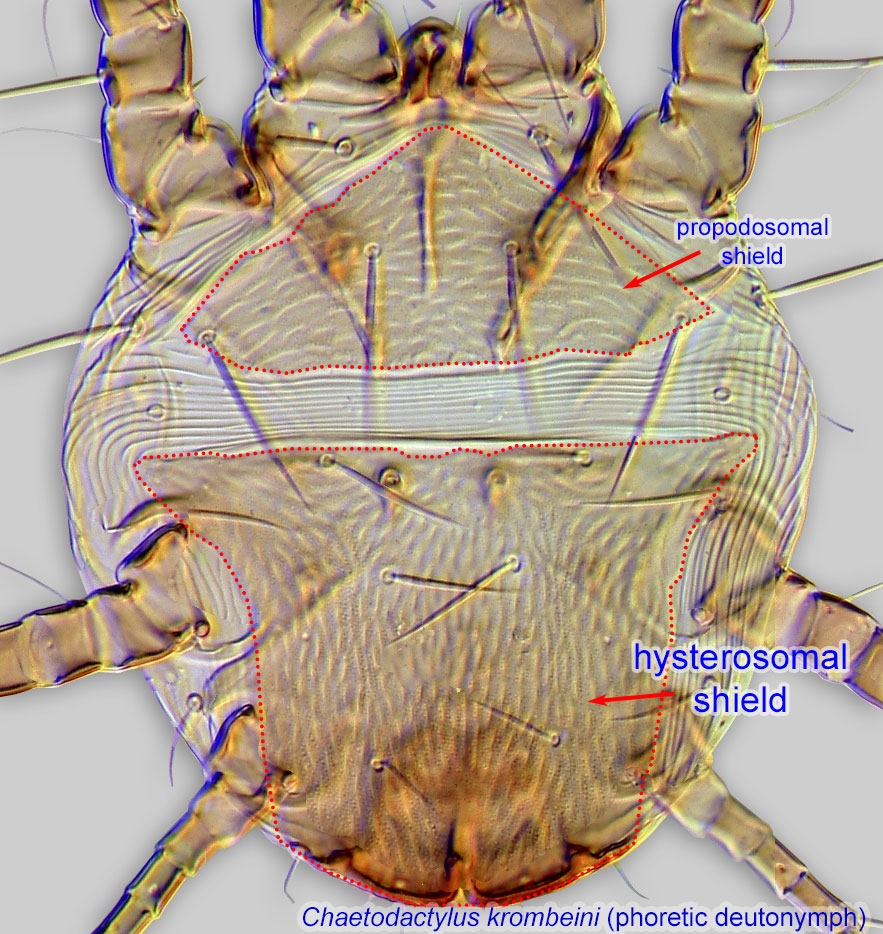 smooth (Fig. 1). Setae ve shorter than vi and smooth (Fig. 1). “Saucer” at the end of tarsal setae e I-II present (Fig. 1). Genugenu:
smooth (Fig. 1). Setae ve shorter than vi and smooth (Fig. 1). “Saucer” at the end of tarsal setae e I-II present (Fig. 1). Genugenu:
Leg or palp segment (also known as podomere or palpomere) between tibia and femur.
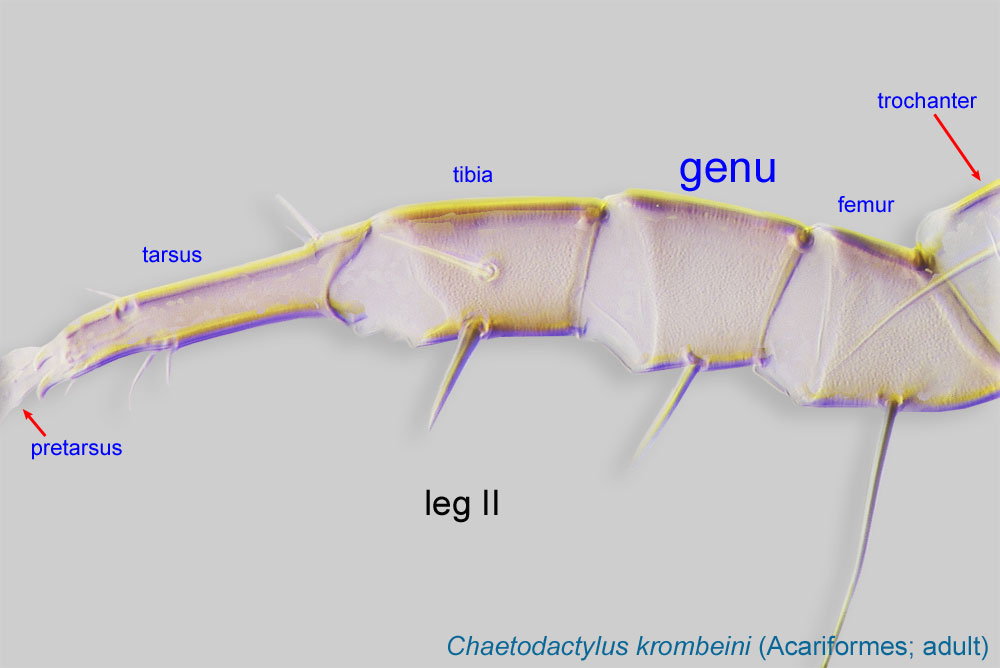 I with two solenidiasolenidion:
I with two solenidiasolenidion:
Thin-walled, terminally rounded or pointed filiform or peglike structure that is not birefringent in polarized light (unlike common setae in Acariformes). Often appears striated because of its internal structure. Found on the palpal tarsus on the gnathosoma and may also occur on the tarsus and tibia, less frequently on the genu, and occasionally on the femur of legs I-IV. In Acariformes, leg solenidia often arise from unsclerotized areas.
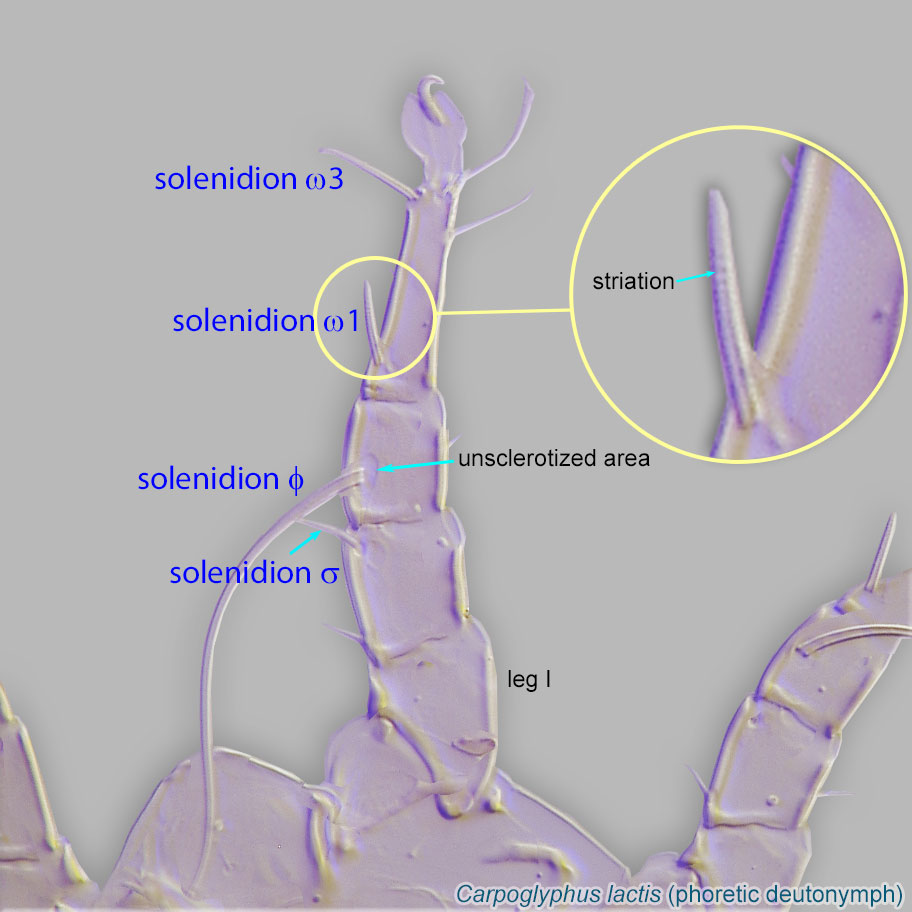 (σ' and σ'') (Fig. 1). External conoidal setae (ps2) of attachment organattachment organ:
(σ' and σ'') (Fig. 1). External conoidal setae (ps2) of attachment organattachment organ:
Complex unpaired structure in phoretic deutonymphs of Astigmata situated on the posteroventral end of the body that serves for attachment to the host during phoresy. In deutonymphs phoretic on insects, attachment organ consists of a vestigial anal opening and two types of attachment elements: true suckers that create negative pressure and conoids that create adhesive forces. Not to be confused with pedicel.
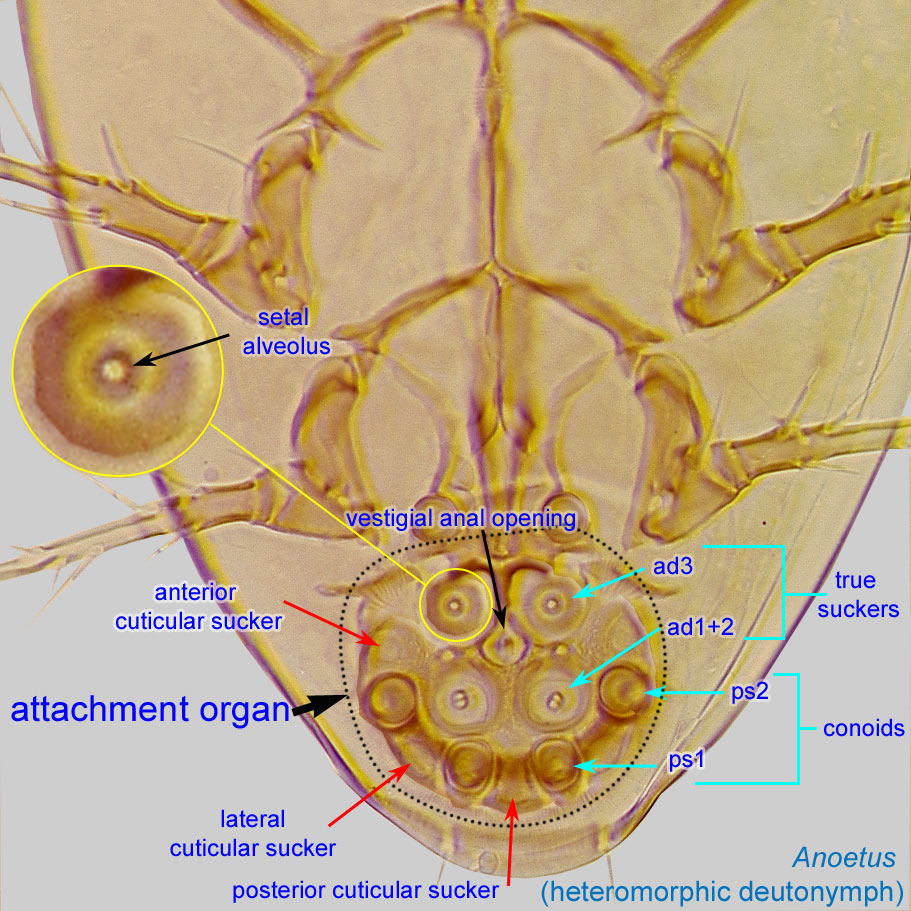 anterior to median suckers (ad1+2) (Fig. 2); ps2 and ps1 accompanied by long, well-developed endosclerites (internal scleritessclerite:
anterior to median suckers (ad1+2) (Fig. 2); ps2 and ps1 accompanied by long, well-developed endosclerites (internal scleritessclerite:
A component section of an exoskeleton; a plate forming the skeleton of an arthropod.
situated under cuticle) (Fig. 2). Solenidionsolenidion:
Thin-walled, terminally rounded or pointed filiform or peglike structure that is not birefringent in polarized light (unlike common setae in Acariformes). Often appears striated because of its internal structure. Found on the palpal tarsus on the gnathosoma and may also occur on the tarsus and tibia, less frequently on the genu, and occasionally on the femur of legs I-IV. In Acariformes, leg solenidia often arise from unsclerotized areas.
 σ III present. Setae nG III present (Fig. 2). Coxal setae 1a, 3a, 4a conoidal (Fig. 2). Claws I-IV subequal (Fig. 2). Long seta on tarsustarsus:
σ III present. Setae nG III present (Fig. 2). Coxal setae 1a, 3a, 4a conoidal (Fig. 2). Claws I-IV subequal (Fig. 2). Long seta on tarsustarsus:
Terminal segment (also known as podomere or palpomere) of legs or palps. In Parasitoformes it can be subdivided into telotarsus and basitarsus.
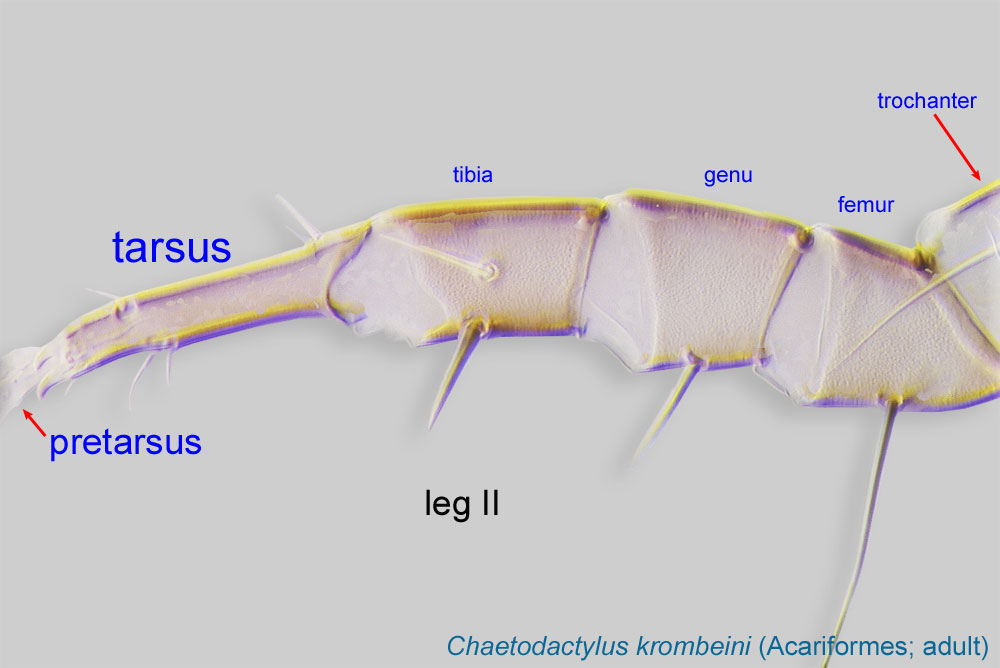 IV (d IV) middorsal (Fig. 2).
IV (d IV) middorsal (Fig. 2).
The two known species can be identified using Zachvatkin, 1941Zachvatkin, 1941:
Zachvatkin, A. A. 1941. Tiroglifoidnue kleshchi Tyroglyphoidea [=Tyroglyphoid mites Tyroglyphoidea]. In Fauna SSSR: Paukoobraznuye, ed. S. A. Zernov, 475. Moscow-Leningrad: Akademiya Nauk SSSR (translated to English in a separate publication)..
Schulzea can be separated from Halictacarus by: 3a represented by conoids (filiform in Halictacarus); ve shorter than vi and smooth (long, as long as vi, and barbed in Halictacarus); hysterosomal shieldhysterosomal shield:
Unpaired shield situated on the dorsal hysterosoma.
 smooth (with distinct pattern of short longitudinal grooves in Halictacarus); conoidal setae ps2 of attachment organattachment organ:
smooth (with distinct pattern of short longitudinal grooves in Halictacarus); conoidal setae ps2 of attachment organattachment organ:
Complex unpaired structure in phoretic deutonymphs of Astigmata situated on the posteroventral end of the body that serves for attachment to the host during phoresy. In deutonymphs phoretic on insects, attachment organ consists of a vestigial anal opening and two types of attachment elements: true suckers that create negative pressure and conoids that create adhesive forces. Not to be confused with pedicel.
 distinctly anterior to median sucker ad1+2 (slightly anterior in Halictacarus); claws IV subequal with claws I-III (distinctly smaller than claws I-III in Halictacarus), leg setae smooth (many leg setae barbed in Halictacarus); long seta on tarsustarsus:
distinctly anterior to median sucker ad1+2 (slightly anterior in Halictacarus); claws IV subequal with claws I-III (distinctly smaller than claws I-III in Halictacarus), leg setae smooth (many leg setae barbed in Halictacarus); long seta on tarsustarsus:
Terminal segment (also known as podomere or palpomere) of legs or palps. In Parasitoformes it can be subdivided into telotarsus and basitarsus.
 IV middorsal (terminal in Halictacarus).
IV middorsal (terminal in Halictacarus).
Palaearctic (Klimov, 1997Klimov, 1997:
Klimov, P. B. 1997. New data on the fauna and biology of acarid mites (Acari, Acaridae) from the Far East. Acarina . 5 : 69-72.; Zachvatkin, 1941Zachvatkin, 1941:
Zachvatkin, A. A. 1941. Tiroglifoidnue kleshchi Tyroglyphoidea [=Tyroglyphoid mites Tyroglyphoidea]. In Fauna SSSR: Paukoobraznuye, ed. S. A. Zernov, 475. Moscow-Leningrad: Akademiya Nauk SSSR (translated to English in a separate publication).) and Nearctic regions (our data, unpublished).
Known from various families of bees: Hylaeus (Prosopis) (Colletidae); Andrena (Hoplandrena) (Andrenidae); and Megachile (Megachilidae).
permanentpermanent:
associated exclusively with bees or their close relative, wasps; cannot live without these hosts
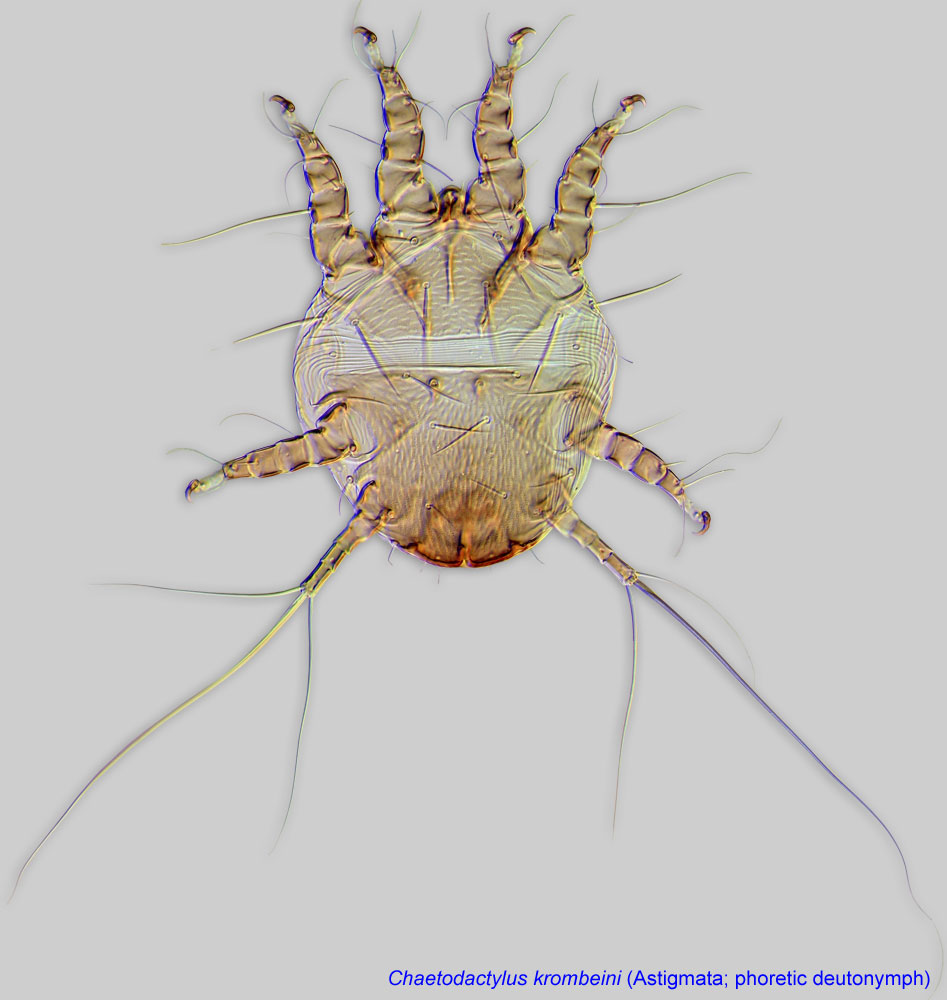 disperse on adult hosts.
disperse on adult hosts.Also recorded from wood-nesting wasps Stigmus and Pemphredon (Crabronidae), and a dung beetle Geotrupes sp. (Geotrupidae). Biology is unknown.